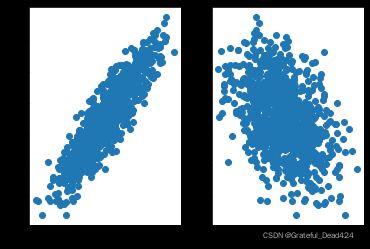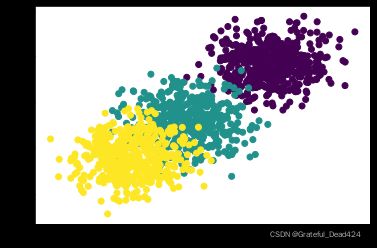Lesson 12.1 深度学习建模实验中数据集生成函数的创建与使用
Lesson 12.1 深度学习建模实验中数据集生成函数的创建与使用
为了方便后续练习的展开,我们尝试自己创建一个数据生成器,用于自主生成一些符合某些条件、具备某些特性的数据集。相比于传统的机器学习领域,深度学习的数据集往往更加复杂,大多数情况也无法把数据生成数据表来进行查看,在建模过程中,往往都是设计完模型结构后直接训练模型,只能通过一些指标来观测模型的效果,外加复杂神经网络内部其实也是“黑箱”,因此我们基本只能控制流程、输入数据、观测结果,说是炼丹师也并不为过。不过在学习阶段,尤其在学习优化算法的过程,我们还是希望能够从更多角度观测数据、观测建模过程,这就需要我们自己动手,创建一些数据用于实验的原材料,通过一些实验深入了解模型原理,从“炼丹师”朝着“化学家”更进一步。
- 导入相关的包
# 随机模块
import random
# 绘图模块
import matplotlib as mpl
import matplotlib.pyplot as plt
# numpy
import numpy as np
# pytorch
import torch
from torch import nn,optim
import torch.nn.functional as F
from torch.utils.data import Dataset,TensorDataset,DataLoader
以上均为此前用到的包,其他的新的包将在使用时再进行导入及介绍
一、回归类数据集创建方法
1.手动生成数据
回归类模型的数据,特征和标签都是连续型数值。
正常情况,应该是对于连续型数值标签的预测,我们采用回归类模型,此处因为先生成数据后进行建模,因此我们称可用于回归模型训练的数据为回归类模型数据,分类模型数据亦然。
- 数据生成
生成两个特征、存在偏差,自变量和因变量存在线性关系的数据集
num_inputs = 2 # 两个特征
num_examples = 1000 # 总共一千条数据
然后尝试通过线性方程,确定自变量和因变量的真实关系
torch.manual_seed(420) # 设置随机数种子
#此处设置所有的数据都是浮点型。
注意,此时labels_true和features满足严格意义上的线性方程关系
y = 2 x 1 − x 2 + 1 y = 2x_1-x_2+1 y=2x1−x2+1
但我们实际使用的标签labels,则是在labels_true的基础上增添了一个扰动项,torch.randn(size = labels_true.shape) * 0.01,这其实也符合我们一般获取数据的情况:真实客观世界或许存在某个规律,但我们搜集到的数据往往会因为各种原因存在一定的误差,无法完全描述真实世界的客观规律,这其实也是模型误差的来源之一(另一个误差来源是模型本身捕获规律的能力)。这其中, y = 2 x 1 − x 2 + 1 y=2x_1-x_2+1 y=2x1−x2+1相当于我们从上帝视角创建的数据真实服从的规律,而扰动项,则相当于人为创造的获取数据时的误差。
这种按照某种规律生成数据、又人为添加扰动项的创建数据的方法,也是数学领域创建数据的一般方法。
- 数据探索
features[: 10]
#tensor([[-0.0070, 0.5044],
# [ 0.6704, -0.3829],
# [ 0.0302, 0.3826],
# [-0.5131, 0.7104],
# [ 1.8092, 0.4352],
# [ 2.6453, 0.2654],
# [ 0.9235, -0.4376],
# [ 2.0182, 1.3498],
# [-0.2523, -0.0355],
# [-0.0646, -0.5918]])
labels[: 10]
#tensor([[ 0.4735],
# [ 2.7285],
# [ 0.6764],
# [-0.7537],
# [ 4.1722],
# [ 6.0236],
# [ 3.2936],
# [ 3.6706],
# [ 0.5282],
# [ 1.4557]])
plt.subplot(121)
plt.scatter(features[:, 0], labels) # 第一个特征和标签的关系
plt.subplot(122)
plt.scatter(features[:, 1], labels) # 第二个特征和标签的关系

不难看出,两个特征和标签都存在一定的线性关系,并且跟特征的系数绝对值有很大关系。当然,若要增加线性模型的建模难度,可以增加扰动项的数值比例,从而削弱线性关系。
# 设置随机数种子
torch.manual_seed(420)
# 修改因变量
labels1 = labels_true + torch.randn(size = labels_true.shape) * 2
# 可视化展示
# 扰动较小的情况
plt.subplot(221)
plt.scatter(features[:, 0], labels) # 第一个特征和标签的关系
plt.subplot(222)
plt.plot(features[:, 1], labels, 'ro') # 第二个特征和标签的关系
# 扰动较大的情况
plt.subplot(223)
plt.scatter(features[:, 0], labels1) # 第一个特征和标签的关系
plt.subplot(224)
plt.plot(features[:, 1], labels1, 'yo') # 第二个特征和标签的关系

当然,我们也能生成非线性关系的数据集,此处我们创建满足 y = x 2 + 1 y=x^2+1 y=x2+1规律的数据集。
# 设置随机数种子
torch.manual_seed(420)
num_inputs = 2 # 两个特征
num_examples = 1000 # 总共一千条数据
# 线性方程系数
w_true = torch.tensor(2.)
b_true = torch.tensor(1.)
# 特征和标签取值
features = torch.randn(num_examples, num_inputs)
labels_true = torch.pow(features, 2) * w_true + b_true
labels = labels_true + torch.randn(size = labels_true.shape) * 0.1
# 可视化展示
plt.scatter(features, labels)
2.创建生成回归类数据的函数
为了方便后续使用,我们将上述过程封装在一个函数内
- 定义创建函数
def tensorGenReg(num_examples = 1000, w = [2, -1, 1], bias = True, delta = 0.01, deg = 1):
"""回归类数据集创建函数。
:param num_examples: 创建数据集的数据量
:param w: 包括截距的(如果存在)特征系数向量
:param bias:是否需要截距
:param delta:扰动项取值
:param deg:方程次数
:return: 生成的特征张和标签张量
"""
if bias == True:
num_inputs = len(w)-1 # 特征张量
features_true = torch.randn(num_examples, num_inputs) # 不包含全是1的列的特征张量
w_true = torch.tensor(w[:-1]).reshape(-1, 1).float() # 自变量系数
b_true = torch.tensor(w[-1]).float() # 截距
if num_inputs == 1: # 若输入特征只有1个,则不能使用矩阵乘法
labels_true = torch.pow(features_true, deg) * w_true + b_true
else:
labels_true = torch.mm(torch.pow(features_true, deg), w_true) + b_true
features = torch.cat((features_true, torch.ones(len(features_true), 1)), 1) # 在特征张量的最后添加一列全是1的列
labels = labels_true + torch.randn(size = labels_true.shape) * delta
else:
num_inputs = len(w)
features = torch.randn(num_examples, num_inputs)
w_true = torch.tensor(w).reshape(-1, 1).float()
if num_inputs == 1:
labels_true = torch.pow(features, deg) * w_true
else:
labels_true = torch.mm(torch.pow(features, deg), w_true)
labels = labels_true + torch.randn(size = labels_true.shape) * delta
return features, labels
注:上述函数无法创建带有交叉项的方程
- 测试函数性能
首先查看扰动项较小的时候的数据情况
# 设置随机数种子
torch.manual_seed(420)
# 扰动项取值为0.01
f, l = tensorGenReg(delta=0.01)
f
#tensor([[-0.0070, 0.5044, 1.0000],
# [ 0.6704, -0.3829, 1.0000],
# [ 0.0302, 0.3826, 1.0000],
# ...,
# [-0.9164, -0.6087, 1.0000],
# [ 0.7815, 1.2865, 1.0000],
# [ 1.4819, 1.1390, 1.0000]])
# 绘制图像查看结果
plt.subplot(223)
plt.scatter(f[:, 0], l) # 第一个特征和标签的关系
plt.subplot(224)
plt.scatter(f[:, 1], l) # 第二个特征和标签的关系
# 设置随机数种子
torch.manual_seed(420)
# 扰动项取值为2
f, l = tensorGenReg(delta=2)
# 绘制图像查看结果
plt.subplot(223)
plt.scatter(f[:, 0], l) # 第一个特征和标签的关系
plt.subplot(224)
plt.scatter(f[:, 1], l) # 第二个特征和标签的关系
# 设置随机数种子
torch.manual_seed(420)
# 2阶方程
f, l = tensorGenReg(deg=2)
# 绘制图像查看结果
plt.subplot(223)
plt.scatter(f[:, 0], l) # 第一个特征和标签的关系
plt.subplot(224)
plt.scatter(f[:, 1], l) # 第二个特征和标签的关系
# 设置随机数种子
torch.manual_seed(420)
# 2阶方程
f, l = tensorGenReg(w=[1], deg=2, bias=False)
plt.scatter(f, l)
二、分类数据集创建方法
和回归模型的数据不同,分类模型数据的标签是离散值。
1.手动创建分类数据集
- 数据生成
在尝试创建分类数据集之前,首先回顾torch.normal创建某种服从正态分布的随机数的创建方法。
torch.randn(4, 2)
#tensor([[ 1.4000, 0.3924],
# [-0.0695, -1.7610],
# [ 0.3227, 1.7285],
# [-0.1107, -1.6273]])
torch.normal(4, 2, size=(10,2))
#tensor([[4.8092, 0.9773],
# [4.4092, 3.3987],
# [1.7446, 6.2281],
# [3.0095, 4.2286],
# [7.8873, 6.5354],
# [3.9286, 4.0315],
# [2.0309, 4.5259],
# [3.6491, 0.7394],
# [3.6549, 5.4767],
# [8.5935, 3.0440]])
接下来尝试创建一个拥有两个特征的三分类的数据集,每个类别包含500条数据,并且第一个类别的两个特征都服从均值为4、标准差为2的正态分布,第二个类别的两个特征都服从均值为-2、标准差为2的正态分布,第三个类别的两个特征都服从均值为-6、标准差为2的正态分布,创建过程如下:
# 设置随机数种子
torch.manual_seed(420)
# 创建初始标记值
num_inputs = 2
num_examples = 500
# 创建自变量簇
data0 = torch.normal(4, 2, size=(num_examples, num_inputs))
data1 = torch.normal(-2, 2, size=(num_examples, num_inputs))
data2 = torch.normal(-6, 2, size=(num_examples, num_inputs))
# 创建标签
label0 = torch.zeros(500)
label1 = torch.ones(500)
label2 = torch.full_like(label1, 2)
# 合并生成最终数据
features = torch.cat((data0, data1, data2)).float()
labels = torch.cat((label0, label1, label2)).long().reshape(-1, 1)
此处需要注意:
-
normal函数的均值参数位、标准差参数位都允许输入高维数组,从而最终输出结果也是形状相同的高维数组;
-
一般来说,约定俗成的方式,是针对多分类问题,类别标记从0开始依次递增;
-
对于PyTorch来说,分类问题标签要求是默认整型。
-
数据探索
features[: 10]
#tensor([[3.9859, 5.0089],
# [5.3407, 3.2343],
# [4.0605, 4.7653],
# [2.9738, 5.4208],
# [7.6183, 4.8705],
# [9.2907, 4.5307],
# [5.8470, 3.1249],
# [8.0364, 6.6997],
# [3.4954, 3.9290],
# [3.8709, 2.8165]])
labels[: 10]
#tensor([[0],
# [0],
# [0],
# [0],
# [0],
# [0],
# [0],
# [0],
# [0],
# [0]])
# 可视化展示
plt.scatter(features[:, 0], features[:, 1], c = labels)

能够看出,类别彼此交叉情况较少,分类器在此数据集上会有不错表现。当然,若要增加分类器的分类难度,可以将各类的均值压缩,并增加方差,从而增加从二维图像上来看彼此交错的情况。
# 设置随机数种子
torch.manual_seed(420)
# 创建初始标记值
num_inputs = 2
num_examples = 500
# 创建自变量簇
data0 = torch.normal(3, 2, size=(num_examples, num_inputs))
data1 = torch.normal(0, 2, size=(num_examples, num_inputs))
data2 = torch.normal(-3, 2, size=(num_examples, num_inputs))
# 创建标签
label0 = torch.zeros(500)
label1 = torch.ones(500)
label2 = torch.full_like(label1, 2)
# 合并生成最终数据
features1 = torch.cat((data0, data1, data2)).float()
labels1 = torch.cat((label0, label1, label2)).long().reshape(-1, 1)
# 可视化展示
plt.subplot(121)
plt.scatter(features[:, 0], features[:, 1], c = labels)
plt.subplot(122)
plt.scatter(features1[:, 0], features1[:, 1], c = labels1)
2.创建生成分类数据的函数
同样,我们将上述创建分类函数的过程封装为一个函数。这里需要注意的是,我们希望找到一个变量可以控制数据整体离散程度,也就是后续建模的难以程度。这里我们规定,如果每个分类数据集中心点较近、且每个类别的点内部方差较大,则数据集整体离散程度较高,反之离散程度较低。在实际函数创建过程中,我们也希望能够找到对应的参数能够方便进行自主调节。
- 定义创建函数
def tensorGenCla(num_examples = 500, num_inputs = 2, num_class = 3, deg_dispersion = [4, 2], bias = False):
"""分类数据集创建函数。
:param num_examples: 每个类别的数据数量
:param num_inputs: 数据集特征数量
:param num_class:数据集标签类别总数
:param deg_dispersion:数据分布离散程度参数,需要输入一个列表,其中第一个参数表示每个类别数组均值的参考、第二个参数表示随机数组标准差。
:param bias:建立模型逻辑回归模型时是否带入截距
:return: 生成的特征张量和标签张量,其中特征张量是浮点型二维数组,标签张量是长正型二维数组。
"""
cluster_l = torch.empty(num_examples, 1) # 每一类标签张量的形状
mean_ = deg_dispersion[0] # 每一类特征张量的均值的参考值
std_ = deg_dispersion[1] # 每一类特征张量的方差
lf = [] # 用于存储每一类特征张量的列表容器
ll = [] # 用于存储每一类标签张量的列表容器
k = mean_ * (num_class-1) / 2 # 每一类特征张量均值的惩罚因子(视频中部分是+1,实际应该是-1)
for i in range(num_class):
data_temp = torch.normal(i*mean_-k, std_, size=(num_examples, num_inputs)) # 生成每一类张量
lf.append(data_temp) # 将每一类张量添加到lf中
labels_temp = torch.full_like(cluster_l, i) # 生成类一类的标签
ll.append(labels_temp) # 将每一类标签添加到ll中
features = torch.cat(lf).float()
labels = torch.cat(ll).long()
if bias == True:
features = torch.cat((features, torch.ones(len(features), 1)), 1) # 在特征张量中添加一列全是1的列
return features, labels
[0, 4, 8] -> [-4, 0, 4] -> [-1, 0 ,1]
[0, 4, 8, 12, 16] -> [-8, -4, 0, 4, 8] -> [-2, -1, 0, 1, 2]
函数整体结构不复杂,且所使用的方法都是此前介绍过的tensor常用方法,唯一需要注意的是函数对于分布离散程度的控制。函数内部变量k是一个随着均值增加和分类类别数量增加而增加的数值,且分类数量增加对k值增加影响是通过和1取平均后进行惩罚的结果。而i*mean_则是一个随着i增加稳步增量的量,二者相减最终能获得一个整体特征均匀分布在0附近的特征张量。
- 测试函数性能
在使用函数的过程中,离散度的第一个数值可以理解为簇的大概分布区间,第二个数值可以理解为每个簇的离散程度。
# 设置随机数种子
torch.manual_seed(420)
# 创建数据
f, l = tensorGenCla(deg_dispersion = [6, 2]) # 离散程度较小
f1, l1 = tensorGenCla(deg_dispersion = [6, 4]) # 离散程度较大
# 绘制图像查看
plt.subplot(121)
plt.scatter(f[:, 0], f[:, 1], c = l)
plt.subplot(122)
plt.scatter(f1[:, 0], f1[:, 1], c = l1)
三、创建小批量切分函数
在深度学习建模过程中,梯度下降是最常用的求解目标函数的优化方法,而针对不同类型、拥有不同函数特性的目标函数,所使用的梯度下降算法也各有不同。目前为止,我们判断小批量梯度下降(MBGD)是较为“普适”的优化算法,它既拥有随机梯度下降(SGD)的能够跨越局部最小值点的特性,同时又和批量梯度下降(BGD)一样,拥有相对较快的收敛速度(虽然速度略慢与BGD)。而在小批量梯度下降过程中,我们需要对函数进行分批量的切分,因此,在手动实现各类深度学习基础算法之前,我们需要定义数据集小批量切分的函数。
另外,后续讲解的交叉验证计算过程也需要对数据进行切分
shuffle过程:将原序列乱序排列
l = list(range(5))
l
#[0, 1, 2, 3, 4]
random.shuffle(l)
l
#[3, 2, 0, 1, 4]
批量切分函数的目标就是根据设置的“批数”,将原数据集随机均匀切分。可通过如下函数实现:
def data_iter(batch_size, features, labels):
"""
数据切分函数
:param batch_size: 每个子数据集包含多少数据
:param featurs: 输入的特征张量
:param labels:输入的标签张量
:return l:包含batch_size个列表,每个列表切分后的特征和标签所组成
"""
num_examples = len(features)
indices = list(range(num_examples))
random.shuffle(indices)
l = []
for i in range(0, num_examples, batch_size):
j = torch.tensor(indices[i: min(i + batch_size, num_examples)])
l.append([torch.index_select(features, 0, j), torch.index_select(labels, 0, j)])
return l
for i in range(0, 5, 2):
print(i)
#0
#2
#4
# 设置随机数种子
torch.manual_seed(420)
# 生成二分类数据集
features, labels = tensorGenCla()
features[:5]
#tensor([[-4.0141, -2.9911],
# [-2.6593, -4.7657],
# [-3.9395, -3.2347],
# [-5.0262, -2.5792],
# [-0.3817, -3.1295]])
torch.tensor(l[0:2])
#tensor([3, 2])
torch.index_select(features, 0, torch.tensor(l[0:2]))
#tensor([[-5.0262, -2.5792],
# [-3.9395, -3.2347]])
labels
#tensor([[0],
# [0],
# [0],
# ...,
# [2],
# [2],
# [2]])
l = data_iter(10, features, labels)
l[0] # 查看切分后的第一个数据集
#[tensor([[ 0.7901, 2.4304],
# [ 4.0788, 3.7885],
# [-1.1552, -0.8829],
# [ 1.3738, 2.3689],
# [-2.1479, -6.6638],
# [-2.5418, -7.9962],
# [-1.0777, -0.7594],
# [ 5.6215, 3.9071],
# [ 3.5896, 3.3644],
# [ 1.2458, 0.0179]]),
# tensor([[1],
# [2],
# [1],
# [1],
# [0],
# [0],
# [1],
# [2],
# [2],
# [1]])]
plt.scatter(l[0][0][:, 0], l[0][0][:, 1], c = l[0][1])
此处又使用了空列表用于存储数据。在经典机器学习领域,我们经常使用空的列表来存储经过处理之后的数据,这么做能让我们非常清楚的看到数据的真实情况,但在深度学习领域,这么做却不是常规操作。在深度学习领域,数据量往往非常大,甚至数据本身就是分布式存储的,要调取数据进行完整的查看,一方面会耗费大量的存储空间,另一方面也会消耗一定的算力,因此PyTorch的Dataset和DataLoader都是将数据进行迭代存储或者映射存储。关于数据生成器大的相关内容我们将在后续进行讨论,此处由于我们是进行手动实验,将处理完的数据完整的存在列表容器中则是为了方便调用查看,是一种更适合初学者的方法。
四、Python模块编写
根据此前介绍的课程安排,本节定义的函数将后续课程中将经常使用,因此需要将其封装为一个模块方便后续调用。封装为模块有以下几种基本方法:
- 打开文本编辑器,将写好并测试完成的函数写入其中,并将文本的拓展名改写为.py;
- 在spyder或者pycharm中复制相关函数,并保存为.py文件;
然后将文件保存在jupyter主目录下,并取名为torchLearning,后续即可通过import torchLearning进行调用。如果是jupyterlab用户,也可按照如下方式进行编写:
Step 1.打开左侧文件管理栏页,点击新建

Step 2.在新建目录中,选择Test File

Step 3.在打开的文本编辑器中输入代码
 需要保存的函数有:
需要保存的函数有:
- tensorGenReg函数
- tensorGenCla函数
- data_iter函数
Step 4.保存退出,并将文件名改写为torchLearning.py

然后即可在其他ipy文件中调用,具体调用方法见下一节内容。







